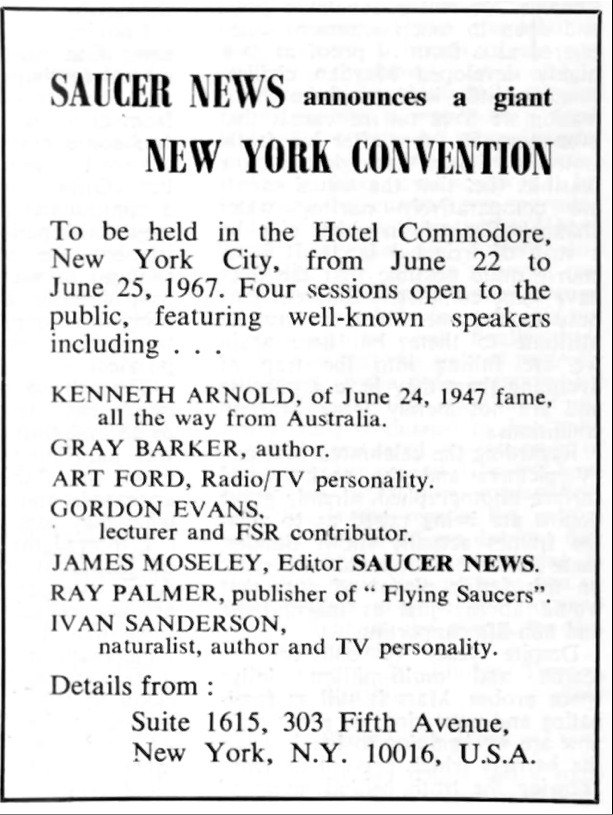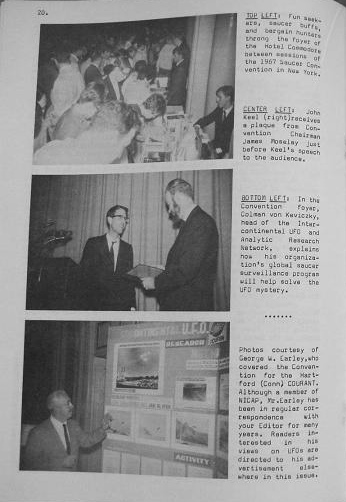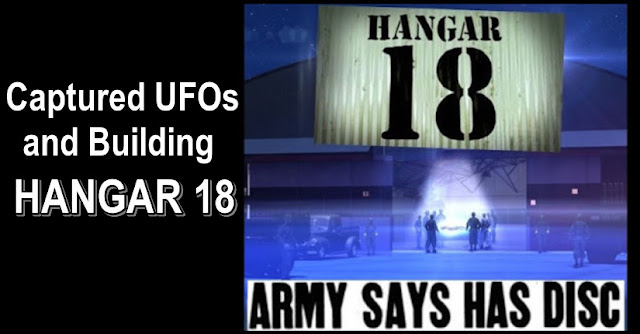Within weeks, maybe days, of Kenneth Arnold’s famous sighting, jokers and hoaxers got started producing fake flying saucers. Reports also came in from Roswell and elsewhere of balloon-launched rawin targets mistaken for flying saucers, with the fakes and mistakes often got more coverage than genuine sightings. Some of the stories talked about the discs being captured or turned over to authorities, and that fueled rumors that an actual flying saucer was in the hands of the military.
1949 - 1950
The January 8, 1950, edition of the Atchison, Kansas Daily Globe, reprinted the Dec. 31, 1949 Amarillo Globe-News page one story by editor Wes Izzard, an anonymously sourced account of the Silas Newton Aztec crashed saucer story:
“... the government has collected several flying saucers and are analyzing them at a secret base in California. This base is not far from Los Angeles.”
January 11, 1950: Variety, “Air Force Asked Twenty Questions” by Frank Scully:
4. Did the Air Force ever make public what the "Explosives," looking like a dismantled flying saucer, were, which they transported in army trucks from a western research base to Dayton, Ohio?
In Behind the Flying Saucers, Scully has a scene where he and Silas Newton meet with Dr. Gee for an interview.
Newton asked, "Where is the little ship?""We have that one in the laboratories at the present time," replied Dr. Gee. "As soon as I get your appointment through I will be authorized to let you inspect it."In time Newton's appointment came through, but by then the ship had been dismantled and reported shipped to Dayton, and all comment thereafter proscribed, denied, or ignored. (Dayton was referring to Wright-Patterson Air Force Base.)
In the section summarizing saucer news stories, Scully mentions his own ‘Twenty Questions,” and comes closest to the Wright Field/Hangar 18 legend:
“Queries indicate that flying saucers were dismantled in New Mexico and Arizona and shipped back to Wright Field, Dayton, Ohio and never heard of since.”
1952
Civilian Saucer Investigation's Ed Sullivan, "To the Man with the Pickle Jar."
“CSI has received hundreds of letters from people seeking the facts behind reports of crashed flying saucers, unknown metals which defy laboratory analysis, mysterious top-level rendezvous in the Australian Bush, and the little man from outer space preserved in a pickle jar... a captured saucer being held under wraps at March Field, as rumor has it.”
Sullivan went on to say that the stories are not backed by any evidence:
“In answer, let us say that we do not believe that any facts are in anyone's possession to support such claims... If there were one single iota of fact, certainly someone, somewhere, would be willing to bring it out into the open.”
1953
Silas Newton had been attending early flying saucer conferences, but at the end of 1953 was facing conviction for fraud for oil swindling, selling phony oil-detection devices he claimed used technology from crashed flying saucers. James Moseley interviewed Newton on Dec. 29, 1953.
“Newton told me that there are two hangars at White Sands at which captured flying saucers are kept. About 15 or 16 saucers are now in government hands. Ordinarily, saucers float toward the earth... saucers contain a mechanism so... it comes gently to rest... The reason some saucers have crashed is that something goes wrong with this mechanism.”
James W. Moseley: Unpublished manuscript
Bill Nash and the Wright Field Story
There was a story circulating among UFO researchers that there was a captured flying similar to what Scully had said, held in secret by the Air Force at “Wright Field, Dayton, Ohio.” Pan American World Airways pilot, Bill Nash became heavily involved in the flying saucer discussion after his own encounter of July 14, 1952, known as the Nash-Fortenberry UFO sighting. He frequently mentioned the "Wright Field Story” in his correspondence, and it later played into him making a sensational claim during a lecture.
Before the program, some tall man… took me down the TV hall…He said that the reason that the saucers were over Wash. in droves in July was because the Air Force had operated a radio found in a cracked up saucer. That the "Wright Field Story” was true - The Air Force had several saucers.
(More on Bill Nash and Wright Field in 1954.)
1954
In their final issue, the organization wanted to leave readers with a summary of what their research had determined. Regarding landed or crashed UFOs:
There is no factual evidence to support any claim that a "flying saucer" has ever landed or set down on the ground, even momentarily. (After discussing a It is also easy to understand how a tall tale recounted in a friendly circle can spread until it is accepted as authentic "flying saucer" lore. During the past two years we have followed such a story of a “captured flying saucer” from March Field, where it was kept under a tarpaulin, progressively through three southern California aircraft plants. This is the one made of the transparent metal, which cannot be machined with a diamond fly-cutter. At last report it had been loaded on a truck at the Hughes Aircraft Company plant and was headed for some unknown destination."
Another good quote from the opening:
People want to know what the UAOs are, and where they come from. They aren’t particularly concerned whether the objects are finally proved to be natural phenomena or whether they may be coming from another planet. Just as long as brass curtains cut off from the public the findings of the various governmental investigations, and no other qualified agency is available to give part of the answers, these same people will continue to accept the irresponsible statements of those who would have us believe that the "little men" have landed, or that there is a Venusian living in Pasadena.
Bill Nash again.
Filling in for his friend, Norman Bean, Bill Nash gave a lecture on flying saucers in March for the Greater Miami Aviation Association. At the end he was asked why he thought the Air force was keeping secrets about saucers. In his answer, Nash gave his opinion based on some rumors he heard, saying he was convinced that the "the Air Force has collected hardware from outer space." There was a reporter in the audience and Nash’s speculative remark became headline news.
 |
| The Day, New London, Conn. Mar 23, 1954 |
WASHINGTON, March 23 (AP)--A spokesman today termed without basis as assertion that the Air Force has recovered hunks of 'flying saucers' and just isn't telling the public about them... Bill Nash, a Pan American World Airways pilot, told the Greater Miami Aviation association recently he was convinced that 'the air force has collected hardware from outer space. I do not believe the air force cares to make all its findings public so long as the United States is threatened by unfriendly powers,' Nash said.”
In exchanges from the same period with Capt. Joe Hull of Capital Airlines (author of the Airline Pilot magazine article, "The Obituary of the Flying Saucers"), Nash tried to persuade Hull of UFO reality. In his letter of April 18, 1954, he went deeper into the rumors that ultimately formed the Hangar 18 legend.
He told Hull about this Miami lecture that started the “hardware” controversy, and repeated the WJZ story he told Keyhoe about meeting the mysterious man with saucer secrets.Nash reports how his friend Norman Bean had been told by an AF major that there was “a saucer at Wright Field,” but he couldn’t be quoted. He said Bean also had several reports from “GI’s who saw the thing on a flat-car, but this is a vague one.”Nash goes on to tell about hearing (what he considered to be a deathbed confession) the “Wright Field Story," how “a flying saucer had been found after landing… and the thing had been brought to Wright Field.”
The Wright Field Story by James W. Moseley
The rumors Bill Nash had heard about a captured saucer were widely circulated and reached Jim Moseley, publisher of Saucer News (then called Nexus). From April to May 1954, Jim heard the story and tape recording from Gene Wolfer, about a woman from the Army who was sick with cancer, and through detective work, Moseley tracked down the source to interview her.
She was Vivian Walton, not a WAC, but a former civilian employee of the Signal Corps of Army at Columbus, Ohio. She said that in 1952, a landed (unmanned) saucer was taken through Columbus Army Supply Depot where it where it was photographed before being taken to Wright Field. Moseley checked with the photographer she reluctantly named, who described Walton as “a night girl on the teletype,” without access to secret materials, and was unable to confirm any portion of her saucer story. She’d seemed sincere, but also discussed details like little bodies and the saucer’s magnetic propulsion that couldn’t have come from the experience she described. In Vivian Walton’s library, Moseley spotted a familiar volume, Behind the Flying Saucers.
“It is perhaps significant that the only saucer book that the Walton’s have is Scully’s.”
Moseley’s report on his investigation sensationalized it a bit, emphasizing the ambiguity between the claims versus the denials. It was published in the Sept. 1954 in Nexus as “The Wright Field Story, or Who's Lying?”
In 1971, the story was expanded into non-fiction book ghost written by Gray Barker, The Wright Field Story, with some added Saucerian flair and drama. There was no mention of a “Hangar 18” in the story or book until it was reprinted in 1992 with some sensational (not in a good way) new material by Timothy Green Beckley.
Hangar 27?
Valor (The Magazine of Soulcraft), October 9, 1954
Desmond Leslie was the co-author with George Adamski of Flying Saucers Have Landed. When interviewed by George Hunt Williamson for Valor, Leslie said he’d investigated the story of a landed flying saucer held at a California Air Force base. An anonymous witness, "an Air Force man" told him that "President Eisenhower had a 'look-see' at the craft during his Palm Springs vacation." The "rumored saucer at Muroc was actually there," under guard, "in hangar 27."
1955
The Flying Saucer Council of America' magazine, The Vimana March 15, 1955, published a story, “Mexican Saucer Landing of 1949 Appears Verifiable... from Three Different Sources” Two versions of the Silas Newton story are given as corroboration, then a 2nd-hand story from an anonymous man’s son: “his son revealed to him, when he was stationed at Wright-Patterson Air base... a huge-semi-truck came into the Air Base, with heavily canopied material jutting out, of immense size... it was shortly driven to a far hangar (was it No. 27? ) where no windows or accessible doors could be discerned.” Frank Scully related either this or a near episode in his ‘Behind the Flying Saucers’ and George Adamski certifies that the above incident is more than likely factual...”
May 23, 1955: Gossip columnist Dorothy Kilgallen sent an INS wire that "the scientific and aeronautic authorities of Great Britain, after having examined the remains of a mysterious airship… have come to the conclusion that these strange flying objects do not represent optical illusions, nor are they Soviet inventions, but that we have to deal with objects that really fly and that originate from some other planet." It’s believed that she was reporting on the hoax of a flying saucer crash in Spitzbergen, Norway. For a detailed examination of this episode, see Patrick Gross’ page, UFOs at close sight.
Flying Saucer News-Service Research Bulletin Oct 20, 1955 relates a far less specific rumor. Not only was the hangar unnumbered, the name of the base wasn't disclosed, just that the saucer was "being housed in a hangar near the northeast sector" at an “eastern air base.” The Bulletin was published in Ohio, so they weren’t describing Dayton’s Wright Field.
1964
Barry Goldwater was supposedly denied entry to see the saucer secrets at Wright Patterson AFB. The name Hangar 18 or Blue Room seems to have been retroactively attached to this tale in later accounts, not used in describing it originally. The earliest version of this story we were able to locate was in 1974, connected with the news of Robert Spencer Carr’s Aztec revival.
Carr contends that Sen. Barry Goldwater (R-Ariz.) had tried to see UFO material at Wright-Patterson during a visit to the base. Radio station WBSR, Pensacola, reached Goldwater's Phoenix office, where a spokesman said that in 1964. when Goldwater was at the base for a ceremony, he asked to enter a building that he heard contained UFO material. The spokesman said Goldwater was told no one was allowed into the building.
AP story printed in The Circleville Herald, Oct 12 1974
1965
Aztec's
"Little Men"
... again
Interplanetary Intelligence Report Vol. 1, No. 4, Nov. 1965, was published by Hayden C. Hewes. It featured a picture of the infamous German 1950 April Fool's Day "Man from Mars" on page 18.
The photo is described as one of the "little men" from the Aztec, NM crash, the debris from which they say was trucked to Wright-Patterson AFB.
The text is all recycled material from Frank Scully's Behind the Flying Saucers, just accompanied by a hoaxed picture the book inspired.
1966
John Fuller, Incident At Exeter
Fuller repeated a rumor that helped get the juices flowing again.
There have been, I learned, after I started the research, frequent and continual rumors (and they are only rumors) that in a morgue at Wright-Patterson Field, Dayton, Ohio, lie the bodies of a half dozen or so small humanoid corpses, measuring not more than four and a half feet in height, evidence of one of the few times an extraterrestrial spaceship has allowed itself either to fail or otherwise fall into the clutches of the semicivilized Earth people.
The rumors continued to circulate, resurface and multiply over the years, but few took them seriously until Robert Spencer Carr relaunched the Aztec story in 1974 with his Hangar 18 story.
. . .
The Blue Room at Wright-Patterson?
 |
| The Blue Room, a 1920 novel by Cosmo Hamilton |
There’s also supposed to be a mysterious “Blue Room” at Wright-Patterson where they hide the UFO secrets, or maybe that’s another name for Hangar 18. Like with the Hangar 18 term, it’s hard to pinpoint its origin. Maybe it started as a verbal gaffe by John R. Blandford, chief counsel for the House Armed Services Committee?
The Secretary of the Air Force, Harold Brown appeared before the House of Representatives, Committee on Armed Services, Washington, D.C., March 31, 1966. After discussing other topics, the chairman turned to the upcoming “Unidentified Flying Objects Hearing by Committee on Armed Services” to be held on April 5, 1966, an inquiry requested by Michigan Representative Gerald Ford.
Brown answered a few questions in preparation for the inquiry:
Secretary Brown: We have an investigation going. Of course we have been doing this since 1948, you know, Mr. Chairman, and in 1965, for example, we investigated almost 900 reports. We will put out a written report which the committee can use to answer these questions.Whether we will ever satisfy all the people who have seen or think they have seen unidentified flying objects, I doubt. But I think we should try to at least satisfy the committee and the Congress.
The Chairman: Yes, sir.
Mr. Blandford: May I suggest to have the officer in charge of this program, at Wright Patterson, here Tuesday morning to indicate that we did have the people who had it — what do they call it, the blue room ?
Secretary Brown: Blue Book.
Mr. Blandford: Have that individual here so it can appear in the record.
"Blue Room" was a familiar name, from restaurants to books and movies. Blandford may not have been the first person to say it instead of Blue Book.

Source:
United States. Congress. House. Committee on Armed Services. Subcommittee No. 3,, . (1966). Hearings on military posture and H.R. 13456 to authorize appropriations during the fiscal year 1967 for procurement of aircraft, missiles, naval vessels, and tracked combat vehicles, and research, development, test, and evaluation for the Armed Forces, and to maintain parity between military and civilian pay, and for other purposes: before the Committee on Armed Services, House of Representatives, Eighty-ninth Congress, 2nd session. Washington, DC: United States Government Printing Office. (1966)
. . .
Acknowledgements
Thanks and acknowledgements to those who provided support, materials, and background detail for this project.
Claude Falkstrom, my co-author, for his work in digging deeper and finding the stories behind the stories, particularly in the case of Lawrence Brill.
Martin Kottmeyer for reference materials from his own Hangar Minus One.
Isaac Koi, for his dedication to the preservation of UFO literature, which helped greatly in the research of this project.
Also, thanks to those who provided other details, materials and verification:
Lance Moody, Brad Sparks, Roger Glassel, Robert Sheaffer, and Rich Hoffman.






































